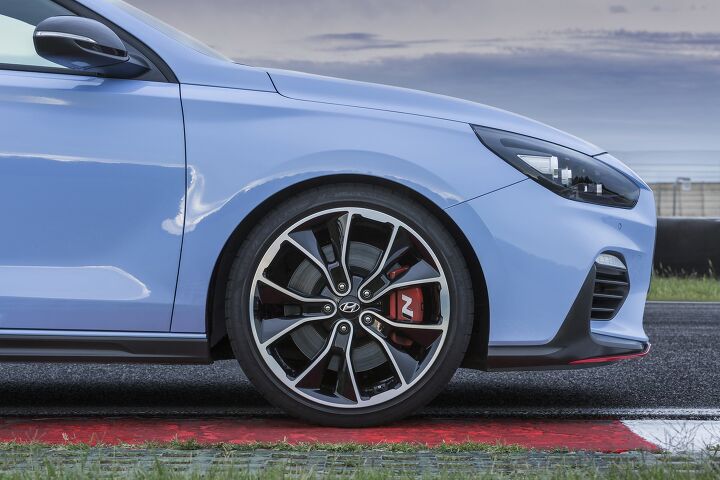Hyundai Delivers a Hotter Hatchback With the I30 N

After four years of development, Hyundai is ushering a new entry into the hot hatchback category with its i30 N. Based on the newest incarnation of the family friendly i30, known throughout North America as the Elantra GT, the N badge separates it as a serious performance model. Hyundai appears to be taking direct aim at the Ford Focus ST and Volkswagen GTI, both through the N’s performance and styling — which seems to be a handsome amalgamation of the pair.
Available in two trims, the base model i30 N provides 246 horsepower while the performance package quipped version bumps that number up to 271 hp. Both use a turbocharged 2.0-liter and six-speed manual transmission and, according to Hyundai, can manage 0-60 times in the low six-second range. Power is sent to the front tires and only to the front tires, with an electronic limited slip differential to keep things manageable in the corners.
It’s a legitimate hot hatch and Hyundai’s first if you discount the Veloster — which you definitely may.
Hyundai seems proud of the technical aspects of the i30 N but claims it wants to focus on a fun car more than anything else. It’s a recipe it hopes to replicate on more models in the future. “The Hyundai i30 N has been developed for no other purpose than to deliver maximum driving fun to our customers in an accessible high-performance package,” explained Albert Biermann, executive vice president of the brand’s performance group. “With the high-performance N models we will enhance our brand’s appeal with emotional products that cater to the needs of people who love to have a smile on their face when they drive their car on a winding road and listen to the sound of the engine.”
The automaker exerted some extra effort on the i30’s variable exhaust valve system’s sound and filled the interior with things like track timers and g-force meters — wholly unnecessary but welcome in something that is supposed to evoke a sensation of sportiness.
There are five selectable driving modes, including Eco, Normal, Sport, N and N Custom. The settings adjust the ferocity of the engine, stability control, electronic differential, steering input, enhanced exhaust sounds, the rev matching. Hyundai also wanted to be clear that stability control could be shut off completely for those interested in “maximum freedom.”
It also comes with Apple CarPlay, Android Auto, and a wireless charging pad for phones. Hyundai also saw fit to toss in a seven-year subscription to Hyundai LIVE — making weather and navigation easily accessible through the car’s 8-inch touchscreen. Safety assists like autonomous emergency braking, lane-keeping, and traffic sign recognition are also standard on the i30 N.
The interior receives elements not found on any other Hyundai. There is a model-specific steering wheel, gearshift knob, high-bolstered sport seats and loads of N logos.
Why exactly Hyundai chose to use the N as a performance demarkation is a bit of a mystery. The automaker claims its shape resembles a chicane and the i30 was tested relentlessly at the Nürburgring circuit, but were (wisely) unwilling to call it a “Nürburgring Edition.” In truth, the brand probably just needed something to that would easily differentiate its performance models and couldn’t call them Type Rs for obvious legal reasons.
Slated to arrive in Europe by the end of 2017, the i30 N’s future in North America is unknown. Hyundai doesn’t appear to have any plans for this continent, where the model would undoubtedly carry an Elantra GT moniker, but hinted that another N car would eventually make an appearance. Based upon some earlier hinting, our best guess is that it’ll be the Veloster — which would only benefit from some beefed-up internals.
[Images: Hyundai]

A staunch consumer advocate tracking industry trends and regulation. Before joining TTAC, Matt spent a decade working for marketing and research firms based in NYC. Clients included several of the world’s largest automakers, global tire brands, and aftermarket part suppliers. Dissatisfied with the corporate world and resentful of having to wear suits everyday, he pivoted to writing about cars. Since then, that man has become an ardent supporter of the right-to-repair movement, been interviewed on the auto industry by national radio broadcasts, driven more rental cars than anyone ever should, participated in amateur rallying events, and received the requisite minimum training as sanctioned by the SCCA. Handy with a wrench, Matt grew up surrounded by Detroit auto workers and managed to get a pizza delivery job before he was legally eligible. He later found himself driving box trucks through Manhattan, guaranteeing future sympathy for actual truckers. He continues to conduct research pertaining to the automotive sector as an independent contractor and has since moved back to his native Michigan, closer to where the cars are born. A contrarian, Matt claims to prefer understeer — stating that front and all-wheel drive vehicles cater best to his driving style.
More by Matt Posky
Latest Car Reviews
Read moreLatest Product Reviews
Read moreRecent Comments
- W Conrad I'm not afraid of them, but they aren't needed for everyone or everywhere. Long haul and highway driving sure, but in the city, nope.
- Jalop1991 In a manner similar to PHEV being the correct answer, I declare RPVs to be the correct answer here.We're doing it with certain aircraft; why not with cars on the ground, using hardware and tools like Telsa's "FSD" or GM's "SuperCruise" as the base?Take the local Uber driver out of the car, and put him in a professional centralized environment from where he drives me around. The system and the individual car can have awareness as well as gates, but he's responsible for the driving.Put the tech into my car, and let me buy it as needed. I need someone else to drive me home; hit the button and voila, I've hired a driver for the moment. I don't want to drive 11 hours to my vacation spot; hire the remote pilot for that. When I get there, I have my car and he's still at his normal location, piloting cars for other people.The system would allow for driver rest period, like what's required for truckers, so I might end up with multiple people driving me to the coast. I don't care. And they don't have to be physically with me, therefore they can be way cheaper.Charge taxi-type per-mile rates. For long drives, offer per-trip rates. Offer subscriptions, including miles/hours. Whatever.(And for grins, dress the remote pilots all as Johnnie.)Start this out with big rigs. Take the trucker away from the long haul driving, and let him be there for emergencies and the short haul parts of the trip.And in a manner similar to PHEVs being discredited, I fully expect to be razzed for this brilliant idea (not unlike how Alan Kay wasn't recognized until many many years later for his Dynabook vision).
- B-BodyBuick84 Not afraid of AV's as I highly doubt they will ever be %100 viable for our roads. Stop-and-go downtown city or rush hour highway traffic? I can see that, but otherwise there's simply too many variables. Bad weather conditions, faded road lines or markings, reflective surfaces with glare, etc. There's also the issue of cultural norms. About a decade ago there was actually an online test called 'The Morality Machine' one could do online where you were in control of an AV and choose what action to take when a crash was inevitable. I think something like 2.5 million people across the world participated? For example, do you hit and most likely kill the elderly couple strolling across the crosswalk or crash the vehicle into a cement barrier and almost certainly cause the death of the vehicle occupants? What if it's a parent and child? In N. America 98% of people choose to hit the elderly couple and save themselves while in Asia, the exact opposite happened where 98% choose to hit the parent and child. Why? Cultural differences. Asia puts a lot of emphasis on respecting their elderly while N. America has a culture of 'save/ protect the children'. Are these AV's going to respect that culture? Is a VW Jetta or Buick Envision AV going to have different programming depending on whether it's sold in Canada or Taiwan? how's that going to effect legislation and legal battles when a crash inevitibly does happen? These are the true barriers to mass AV adoption, and in the 10 years since that test came out, there has been zero answers or progress on this matter. So no, I'm not afraid of AV's simply because with the exception of a few specific situations, most avenues are going to prove to be a dead-end for automakers.
- Mike Bradley Autonomous cars were developed in Silicon Valley. For new products there, the standard business plan is to put a barely-functioning product on the market right away and wait for the early-adopter customers to find the flaws. That's exactly what's happened. Detroit's plan is pretty much the opposite, but Detroit isn't developing this product. That's why dealers, for instance, haven't been trained in the cars.
- Dartman https://apnews.com/article/artificial-intelligence-fighter-jets-air-force-6a1100c96a73ca9b7f41cbd6a2753fdaAutonomous/Ai is here now. The question is implementation and acceptance.






































Comments
Join the conversation
Love it other than the red exterior accents and the fact it's manual only. There should be a law somewhere that all non-electrified cars must offer both an automatic and manual, something for everyone. Also I'm ok with Hondas or Mazdas being manual-only since those manufacturers are known for their prowess in that area. Hyundai is not.
*LOVE* the i30N! And love the fact that it's offered with a manual tranny. But why not bring it to North America? I would certainly consider buying this but never look at the Veloster because it's impractical.